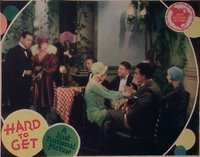 Sloe-eyed, swan-necked Dorothy Mackaill (1903-1990) seemed to be finally coming into her own just as the talkies took hold --- but true mega-stardom eluded her. Why? Was it the fact that she'd been a supporting player for so long, and in so many films, that audiences looked upon her as an old friend rather than a "new exciting discovery" during a period in film already saturated with new names and faces? Or was it her own restless, somewhat defiant and fickle, personality that didn't move her to seek fame in the way it did others?
Sloe-eyed, swan-necked Dorothy Mackaill (1903-1990) seemed to be finally coming into her own just as the talkies took hold --- but true mega-stardom eluded her. Why? Was it the fact that she'd been a supporting player for so long, and in so many films, that audiences looked upon her as an old friend rather than a "new exciting discovery" during a period in film already saturated with new names and faces? Or was it her own restless, somewhat defiant and fickle, personality that didn't move her to seek fame in the way it did others?Born in Hull, Yorkshire, England in 1903, she'd arrive in Hollywood via what seems almost a text-book route to fame. Running away from school (The Thorne Academy in London), joining the chorus at the London Hippodrome, becoming an overnight sensation for performing a novelty dance called "The Chicken Walk," an introduction to film acting in Paris when the show traveled there, and then to New York. As Mackaill would recollect in 1929, she crashed the stage-door at a revival of "Florodora," and met with Lee Shubert who found her a part. Using this as leverage, she arranged a meeting with Ziegfeld ("Dorothy Mackaill of London to see Mr. Ziegfeld" she loudly announced in the producer's outer office,) and impressed with her nerve, voice and legs, she was put into the roof garden's "Midnight Frolic" show, and into the costumes of departing actress Jacqueline Logan.
Small film roles soon followed, and after co-starring with Richard Barthelmess in "The Fighting Blade" and "Twenty One" (both 1923) she was contracted to go to Hollywood. However, her next film performed so poorly that she ripped up her contract (she claims) and instead accepted a dodgy offer from two producers in the process of forming Syracuse Pictures --- a company they claimed would soon make the small upstate New York city "an Eastern Hollywood." Signed as star for the only two films the company would produce, when Syracuse Pictures folded, Mackaill gladly accepted work with First National where, with her newly bobbed hair, she made an impact that was to last for the remainder of the decade and into the next.
After supporting Jack Mulhall and others in a string of successful, albeit lightweight films, she was in the right place at the right time when sound films began to emerge, and when "The Barker" (1928) was hastily re-tooled to include talking sequences, Mackaill clicked.
Released in late Summer of 1929, "Hard To Get," (First National & Vitaphone) is a lost film, and like the greater majority of lost films it's neither eagerly sought after, spoken of in hushed tones tinged with yearning, or written about with trembling hand. Rather, it was just one of many films produced that year that aspired to little more than turning a profit when all was said and done. Based upon the Edna Ferber short story "Classified," there was nothing here that hadn't already been on the screen countless times and under countless guises. Mackaill portrays a working girl employed as a mannequin in a chic dress salon, who yearns for more than a workaday world and an ordinary home life. Her parents, played by James Finlayson and Louise Fazenda (now that's a combination worthy of at least a somewhat hushed tone!) and loutish brother (surprise --- Jack Oakie!) like everything just as it is, as does her auto mechanic boyfriend, Charles Delaney.
Of course, Mackaill will have none of this and soon sets a bright eye on millionaire Edmund Burns who quickly responds. Period reviews invariably cite a sequence during which Makaill's family meets the elegant suitor as one of the highlights of the film and given the cast, it's impossible not to sigh with regret at likely not ever being able to see for ourselves. But, to move on bravely, the suave Burns soon shows himself to be vastly less a man than, say, an auto mechanic or loutish brother are --- and Mackaill turns tail and returns to kith and kin, wiser but not particularly remorseful for what amounted to a grand adventure.
Mackaill would go on to make numerous other films, many of them far more extravagant and memorable, such as 1930's all-Technicolor "Bright Lights" and particularly the still astounding "Safe In Hell" of 1931. With her First National contract dropped in 1931 and seen thereafter in the sort of roles and films you'd expect to find Constance Bennett or Kay Francis in, Mackaill seemed to be edged out by bigger box office draws and slowly but surely faded from a spotlight that never quite reached it's full potential.

Deemed suitable for overseas export, "Hard to Get" was fitted out with a new synchronized Vitaphone soundtrack to accompany the film (see the post "In the Land of Jazz" for details on this process) and apparently played foreign venues where the Spanish language was the norm. It is a set of discs for this version that survives and is at hand, although I suspect the English language discs are out there too. While chock full of period pop tunes, themes lifted from other Vitaphone productions of 1929, and a variety of sound effects, the only voice to be heard on the Spanish language version discs is that of a regrettably unknown male vocalist beautifully rendering the film's infinitely charming theme song in a sequence set in a night club.
"Hard to Get" (1929) Vitaphone Disc Excerpt
And, for those who'd like to hear an English language, more up-tempo version of the same tune... Why, here's Allan Selby's Frascations (of Frasciti's Restaurant, Oxford Street, London) waiting to perform it for you.
"Hard to Get" (1929) The Frascatians


No comments:
Post a Comment